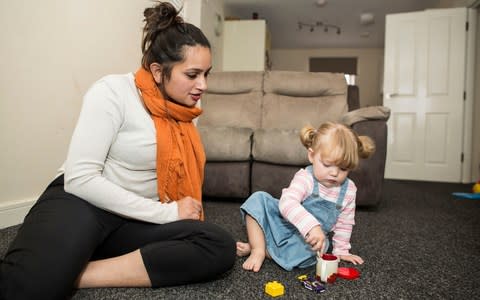Some are born great? No, with the right start in life we all have the same chance to succeed

Five-year-old Isaac Brook adores football, supports Tottenham Hotspur and loves playing with his brother. He has just started school in rural Oxfordshire and is eagerly learning to read. “He’s taken to school like a duck to water. He loves it. He’s very sociable and good at making friends,” says his mother, Lydia. In other words, he is a very normal, happy little boy.
Yet there is something remarkable about Isaac. His early progress through life has helped to set the standard for other children across the world. Isaac is one of more than 1,300 children in five countries – Brazil, India, Italy, Kenya and the UK – whose growth and neurodevelopment has been tracked and compared from the earliest days in the womb until the age of two.
Led by a team at the University of Oxford, the INTERGROWTH-21st Project is set to have a profound impact on the way we view, feed and educate our children. It has shown for the first time that children are born physically and intellectually equal, regardless of their race or ethnicity. Given good living conditions, good food and education, babies thrive, wherever they live and whatever the colour of their skin.
Such is the power of the data gathered, the researchers hope it will be used alongside the World Health Organisation’s growth charts worldwide, including its Red Book in the UK. It should finally put to bed outdated notions of racial or class-based superiority.
The research tracks both physical and intellectual development to age two. A child’s first 1,000 days of life (from conception to 24 months) is the most crucial because that is when the brain grows fastest, accounting for roughly two-thirds of its adult weight.

“At every single stage we’ve shown that healthy mothers have healthy babies, and that healthy babies all grow at exactly the same rate,” says Prof Stephen Kennedy, the co-director of the Oxford Maternal and Perinatal Health Institute and co-leader of the INTERGROWTH-21st Project (with José Villar, a professor of perinatal medicine). “It doesn’t matter where you are living, it doesn’t matter what the colour of your skin is, it doesn’t matter what your race and ethnicity is, receiving decent medical care and nutrition is the key.”
The assertion that healthy mothers have healthy babies – regardless of where they come from – sounds obvious but demonstrating it in terms of growth and developmental milestones is a first.
Until now, it was a commonly held view that some babies were naturally smaller than others due to genetic predisposition: a healthy baby born to a Kenyan mother, say, would be smaller than a counterpart born to a British mother. America’s National Institutes for Health even produced differing foetal growth charts for babies of white, black, and Asian origin.
Assumptions have also – though more controversially – been made about the intellectual ability of different races. Only last week the Cold Spring Harbour Laboratory in the US cut its ties with James Watson, the Nobel Prize-winning geneticist who, with Maurice Wilkins and Francis Crick, first proposed the double helix structure of DNA, citing his “unsubstantiated and reckless” remarks about race and intelligence. Watson, the laboratory’s former chancellor, has repeatedly suggested that genes cause a disparity in average scores in IQ tests between blacks and whites.

“There’s still a substantial body of opinion out there in both the scientific and lay communities who genuinely believe that intelligence is predominantly determined by genes and the environment that you’re living in and that your parents and grandparents were living in and their nutritional and health status are not relevant,” says Prof Kennedy. “Well, that’s clearly not the case.”
The Oxford study took seven years to complete and involved nearly 60,000 mothers and babies in two stages of research, first tracking growth in the womb, before following more than 1,300 of those babies to age two. Its results show that not only physical growth but behaviour and neurodevelopmental milestones occur at the same rate among babies of differing ethnic origin. The findings echo the assertion by Craig Venter, the scientist who led the first draft of the sequencing of the human genome, that “there is no basis in scientific fact or in the human genetic code or the notion that skin colour will be a predictive of intelligence”.
Previous research into gestational growth has taken ethnic origin but not living conditions into account. Where mothers of a similar social, economic and health status are compared, the Oxford team has shown, healthy Indian and African babies will grow at the same rate as healthy, well-nourished Britons.
The women enrolled into the second part of the INTERGROWTH-21st Project – whether in Brazil, India, Italy, Kenya or Oxford in the UK – were carefully selected to achieve a like-for-like comparison: urban women of similar age with a healthy BMI who were non-smokers and living in a clean environment. “It is important to say these were not superwomen, they were simply well-educated and well-nourished,” says Kennedy.
“In the centres we selected, one-third of the women met our criteria for being healthy. So this wasn’t a tiny slice of the population.”
Babies were weighed and measured (including head circumference) at birth, then at one and two years of age. The team tracked fundamental motor milestones according to WHO norms, such as the age at which the child first stood or walked alone, but also developed its own, culturally neutral set of tests for cognition, language, behaviour and motor development.
At the age of two, the children were given a series of play-related tasks. “You might build a tower using five blocks, then knock it down,” says Dr Michelle Fernandes, the Oxford researcher who devised the tests. “Will the child respond by building another tower, completely or partially, or make no effort to do so? If you place a number of objects in front of the child – a cup, spoon, sock, shoe and cube – and ask them to put the spoon in the cup, without giving them a visual cue, are they able to do so?”

Cognitive development was also assessed by placing an attractive object under one cloth, then another, then asking the child to find it. If the child immediately lifted the second cloth, it showed they had been able to follow the sequence of moves. “There are no zero scores,” says Dr Fernandes, “because the child is always able to do something, whether it is building a tower, but with only three blocks, or searching for the beads under the first cloth.”
Additional information on the children’s behavioural progress, including lavatory training, was obtained by questioning the mothers.
In 1995, the WHO decided that human growth and development should be assessed and monitored using international standards. The resulting standards, published in 2006, form the basis of the Red Book familiar to families in Britain whose babies’ growth is assessed in centiles in relation to the graph.
The WHO standard applied to children aged 0-5 (born at full-term) but did not study the foetus. The Oxford study fills in the gap, charting children’s progress from the earliest weeks of life. “
By assessing not only growth but neurodevelopment at two years of age we have done something the WHO didn’t,” says Prof Kennedy.
“Our standards for establishing gestational age, monitoring the growth of the foetus, assessing the newborn size and post-natal growth on preterm babies... all of those overlap and complement the WHO standards. Taken together, they provide a gold standard which should be used by every country in the world.”
The INTERGROWTH-21st standards are likely to focus doctors’ – and hopefully parents’ – attention on the quality of food pregnant women and young infants consume. While the study shows all children should grow up equally able, it is a lack of good nutrition in the first thousand days that is likely to make the biggest difference to a child’s future.
Across the world, there are estimated to be more than 150 million children (22 per cent) who have become physically and mentally “stunted” because of poor nutrition in their early years. Although largely an overseas problem, recent international data showed that 10 per cent of UK children live in conditions of “severe food insecurity”.
Just as problematic, worrying numbers of babies are born overweight, putting them at risk of health problems including diabetes later in life. A report from the Royal College of Paediatricians and Child Health this week flags up concern over child poverty in the UK – a contributory factor in childhood obesity and poor mental health – and the UK’s poor rate of breastfeeding, believed to be among the lowest in the world. The UK infant feeding survey, usually carried out every five years, was cancelled in 2015.
The Oxford team is now launching a new study, INTERPRACTICE-21st, to examine the growth and development of preterm babies. It has been normal practice to monitor those babies born below 32 weeks of gestation, but it is assumed those born between 33 and 37 weeks, though early, will “catch up”. It may be that any baby born early is at risk of developmental delay.
The INTERGROWTH-21st Project has come to an end but its findings convey a powerful message about what can be achieved worldwide if mothers and babies have access to good food, education and a decent environment. In such circumstances, the attainment of neurodevelopmental milestones and associated behaviours “are likely innate and universal” the researchers say: and that commonality must be good news for us all.
Protect yourself and your family by learning more about Global Health Security


 Yahoo News
Yahoo News 
